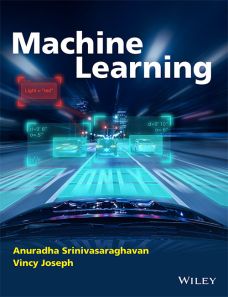Machine Learning
ISBN: 9788126578511
328 pages
Publication Year: 2019
eBook also available for institutional users
For more information write to us at: acadmktg@wiley.com

Description
This book offers the readers the basics of machine learning in a very simple, user-friendly language. While browsing the Table of Contents, you will realize that you are given an introduction to every concept that comes under the umbrella of machine learning. This book is aimed at students who are new to the topic of machine learning. It is meant for students studying machine learning in their undergraduate and postgraduate courses in information technology. It is also aimed at computer engineering students. It will help familiarize students with the terms and terminologies used in machine learning. We hope that this book serves as an entry point for students to pursue their future studies and careers in machine learning.
Part 1 Basics of Machine Learning
Chapter 1 Introduction to Machine Learning
1.1 What is Machine Learning?
1.2 Where is Machine Learning Used?
1.3 Applications of Machine Learning
1.4 Types of Machine Learning
Chapter 2 Model and Cost Function
2.1 Introduction
2.2 Representation of a Model
2.3 Cost Function Notation for Measuring the Accuracy of a Hypothesis Function
2.4 Measuring Accuracy of a Hypothesis Function
2.5 Minimizing the Cost Function for a Single-Variable Function
2.6 Minimizing the Cost Function for a Two-Variable Function
2.7 Role of Gradient Function in Minimizing a Cost Function
Chapter 3 Basics of Vectors and Matrices
3.1 Introduction
3.2 Notations
3.3 Types of Matrices
3.4 Matrix Operations
3.5 Determinant of a Matrix
3.6 Inverse of a Matrix
Chapter 4 Basics of Python
4.1 Introduction
4.2 Installing Python
4.3 Anaconda
4.4 Running Jupyter Notebook
4.5 Python 3: Basic Syntax
4.6 Python Identifiers
4.7 Basic Operators in Python
4.8 Python Decision-Making
4.9 Python Loops
4.10 Numerical Python (NumPy)
4.11 NumPy Matplotlib
4.12 Introduction to Pandas
4.13 Introduction to Scikit-Learn
Chapter 5 Data Preprocessing
5.1 Overview of Data Preprocessing
5.2 Data Cleaning
5.3 Data Integration
5.4 Data Transformation
5.5 Data Reduction or Dimensionality Reduction
Part 2 Supervised Learning Algorithms
Chapter 6 Artificial Neural Networks
6.1 Introduction
6.2 Evolution of Neural Networks
6.3 Biological Neuron
6.4 Basics of Artificial Neural Networks
6.5 Activation Functions
6.6 McCulloch–Pitts Neuron Model
Chapter 7 Linear Regression
7.1 Introduction to Supervised Learning and Regression
7.2 Statistical Relation between Two Variables and Scatter Plots
7.3 Steps to Establish a Linear Regression
7.4 Evaluation of Model Estimators
7.5 Solved Problems on Linear Regression
Chapter 8 Logistic Regression
8.1 Introduction to Logistic Regression
8.2 Scenarios Which Require Logistic Regression
8.3 Odds
8.4 Building Logistic Regression Model (Logit Function)
8.5 Maximum Likelihood Estimation
8.6 Example of Logistic Regression
Chapter 9 Decision Tree
9.1 Introduction to Classification and Decision Tree
9.2 Problem Solving Using Decision Trees
9.3 Basic Decision Tree Learning Algorithm
9.4 Popularity of Decision Tree Classifiers
9.5 Steps to Construct a Decision Tree
9.6 Classification Using Decision Trees
9.7 Issues in Decision Trees
9.8 Rule-Based Classification
9.9 Pruning the Rule Set
Chapter 10 Support Vector Machines
10.1 Introduction to Support Vector Machines
10.2 Linear Support Vector Machines
10.3 Optimal Hyperplane
10.4 Basics of Vectors
10.5 Radial Basis Functions
Chapter 11 Bayesian Classification
11.1 Introduction to Bayesian Classifiers
11.2 Naive Bayes Classifier
11.3 Bayesian Belief Networks
11.4 k-Nearest Neighbor (KNN)
11.5 Measuring Classifier Accuracy
Chapter 12 Hidden Markov Model
12.1 Introduction to Hidden Markov Model
12.2 Issues in Hidden Markov Model
Part 3 Unsupervised Algorithms
Chapter 13 Introduction to Unsupervised Learning Algorithms
13.1 Introduction to Clustering
13.2 Types of Clustering
13.3 Partitioning Methods of Clustering
13.4 Hierarchical Methods
Part 4 Optimization Techniques
Chapter 14 Optimization
14.1 Introduction to Optimization
14.2 Classification of Optimization Problems
14.3 Linear vs Nonlinear Programming Problems
14.4 Unconstrained Minimization Problems
14.5 Gradient-Based Methods (Descent Methods)
14.6 Introduction to Derivative-Free Optimization
14.7 Derivative-Based vs Derivative-Free Optimization
Summary
Multiple-Choice Questions
Very Short Answer Questions
Short Answer Questions
Review Questions
Answers
Appendices
Bibliography
Index

